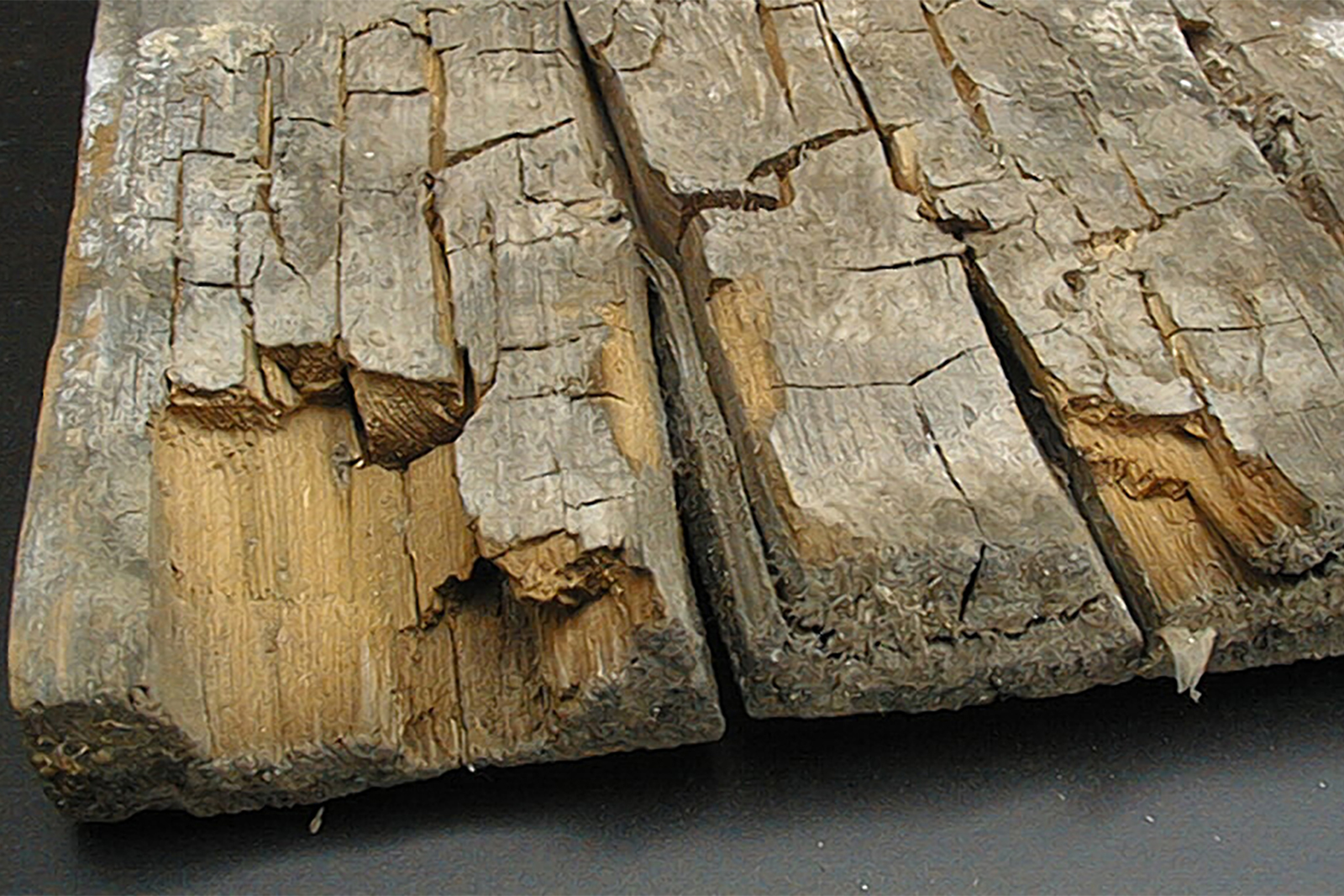Dry rot
Dry rot (Serpula lacrymans) is a wood-destroying fungus that is found in most parts of the world. Although it affects forest timbers, dry rot is best known for its ability to destroy timbers in ships and buildings.
FAQ
-
What is dry rot?
Dry rot is a type of wood-decaying fungus that digests wood. It is an aggressive growth that feeds on moisture and timber and spreads in the wild as well as on man-made wooden structures. -
What does dry rot look like?
Each stage of dry rot growth is unique. The mycelium growth is white and furry, while the fruiting body (Sporophore) is a rusty and metallic orange-red colour. Timber damaged by dry rot will be fragile, brittle, dried out and warped. -
What causes dry rot?
Dry rot occurs when Serpula Lacrymans fungal spores settle on wood with moisture levels in excess of 20%. Timber that is not already damp prior to growth will not germinate dry rot. -
How to treat dry rot?
Dry rot almost always needs professional attention as it causes extremely aggressive and widespread damage to timber. Treatment requires the total removal of affected wood. The removal of all moisture sources. Affected wood to dry out. The application of a wood preservative to further prevent future infection. -
How much does dry rot treatment cost?
Dry rot treatment can be more expensive than prevention. The removal and replacement of affected timber can be a costly process, depending on how advanced the infection is. Following treatment, Roxil Wood Preserver is a great preventative measure to stop rot reoccurrence. -
Is dry rot dangerous?
Dry rot is dangerous because it grows very quickly and makes timber structurally unstable. You should never enter a structure with a known or suspected dry rot infestation.
Identification of Dry Rot
It is important to identify whether timber decay has been caused by dry rot or another wood-destroying fungus such as one of the wet rots. This is because dry rot has the ability to travel through building materials other than timber, giving outbreaks the potential to spread quickly through a building. For this reason additional measures (e.g. masonry sterilisation) often have to be taken when treating dry rot outbreaks over and above those necessary when dealing with outbreaks of other wood-rotting fungi.
Typical indications of dry rot include:
- Wood shrinks, darkens and cracks in a ‘cuboidal’ manner (see picture)
- A silky grey to mushroom coloured skin frequently tinged with patches of lilac and yellow often develops under less humid conditions. This ‘skin’ can be peeled like a mushroom.
- White, fluffy ‘cottonwool’ mycelium develops under humid conditions. ‘Teardrops’ may develop on the growth.
- Strands develop in the mycelium; these are brittle and when dry and crack when bent.
- Fruiting bodies are a soft, fleshy pancake or bracket with an orange-ochre surface. The surface has wide pores.
- Rust red coloured spore dust frequentky seen around fruiting bodies.
- Active decay produces a musty, damp odour.
Dry rot can cause widespread structural damage. We recommend that a professional timber treatment company is called in to carry out a survey if dry rot is suspected. If you suspect dry rot, please contact our technical department on 01403 210204 or submit an enquiry and we will be happy to arrange for an experienced timber treatment company to contact you.
Dry Rot Control and Treatment




Dry rot fruiting body

Dry rot cuboidal cracking

Dry rot tear drops




Dry rot fruiting body

Dry rot cuboidal cracking

Dry rot tear drops
Dry rot will only affect timber that is damp, typically affecting timber with a moisture content in excess of 20%. For this reason, removing the source of moisture should form the core of any dry rot eradication strategy.
Timber can become damp for a number of reasons. Among the most common causes are leaking washing machines, shower trays, baths, condensation etc… The dampness can also come from outside the building, for example, leaking roofs, rising dampness, or dampness penetrating through walls. Whatever, the source of the dampness, if it is rectified and the timber allowed to properly dry out, the dry rot will eventually be controlled.
However, it is not always possible or practical to be sure that the timbers will remain dry in the long term. Therefore, it is important that secondary measures are taken to defend against re-infection. Any affected timbers should be removed and replaced with pre-treated timber. Any remaining timbers at risk of being affected by the dry rot should be treated with an effective fungicide. Where the dry rot has passed through the masonry, it should be isolated using physical containment and / or masonry sterilisation.
Safeguard’s ProBor range of wood preservatives are particularly suitable fungicides for the treatment of dry rot, as they are able to spread much more deeply into the timber than conventional preservatives. This gives them an extensive performance advantage, as no wood preservative can start working until it comes into contact with the fungi that it is designed to defend against.
Free Dry Rot Book
A more comprehensive 19-page guide, Dry Rot & its Control can be downloaded free of charge from the ‘Downloads’ tab on this page in Adobe Acrobat (pdf) format. This publication gives more detailed guidence on the identification and treatment of dry rot.